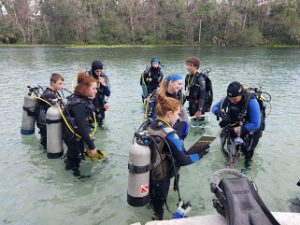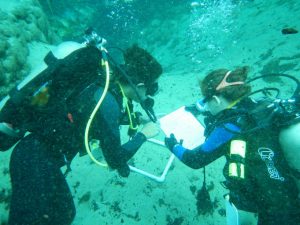by Vivian F., Chelsea D, and introducing new Naut, Zane S.!

SCUBAnauts prepare to investigate the presence of snails in relation to submerged aquatic vegetation (SAV) in Alexander Springs this December.
Alexander Springs is a spring system connected to the Florida Aquifer. Water from the aquifer finds its way through natural openings in the ground. This was the site of our dive on December 30th. Our dive was 74 degrees Fahrenheit. The only noticeable current was from the aquifer leaking into the spring, but still there was sand everywhere due to a warm water vent stirring up the settlement. Before our dive, we gathered and talked about what our study was going to be. We talked about how we were going to look at the possible relationship between species of applesnails and the percentage of submerged aquatic vegetation (SAV) coverage. We then broke into groups to discuss the division of labor and how exactly we were going to record what we saw. We formed group hypotheses and methodology. Each group was provided a quadrat and a transect line as well as underwater paper to conduct our experiments. We measured SAV percent coverage and counted snails. While there was evidence of snails having lived there, we actually recorded no living snails! (We did find some dead snails which were mostly Florida Applesnails.) However, counting 0 living snails is STILL data! It is still knowledge that we did not have before the dive. This brought us to a new question though, as science often does: why were there no snails? And of course, we cannot tell if there is a relationship between applesnails and SAV, so more tests are needed!

Divers use a quadrat and underwater paper to record the presence of two snail species (or in this case–the lack thereof) of apple island snails and Florida apple snails.
Zane S. is a brand new SCUBAnaut. This trip to Alexander Springs was Zane’s first dive with the group. This is what he said about the adventure:
“On the dive in Alexander Springs, we measured plant growth on the bottom with square devices by flipping the squares to measure the percentage of plant growth for each plant. We also counted the amount of invasive apple snails and native apple snails that were eating the algae found on sea grass. The water was very clear where we dove, and I saw lots of plants that we were able to use for our research in the waters. It was such a cool experience that I will never forget and hope to one day do again.”

